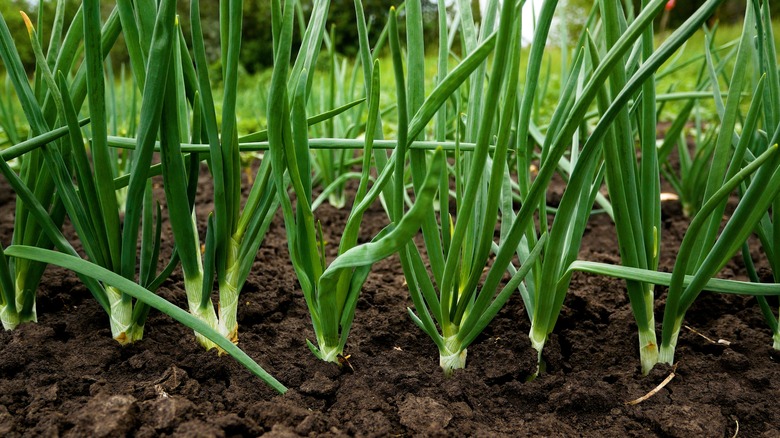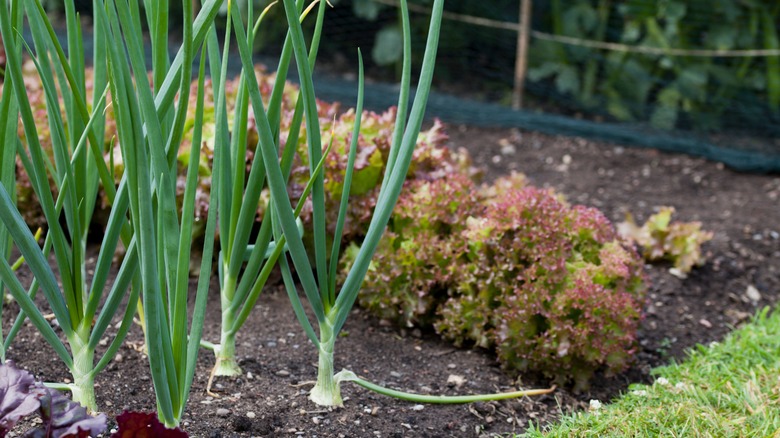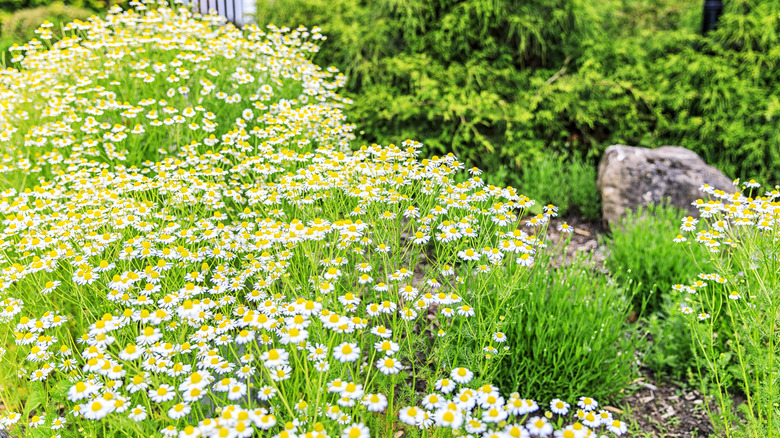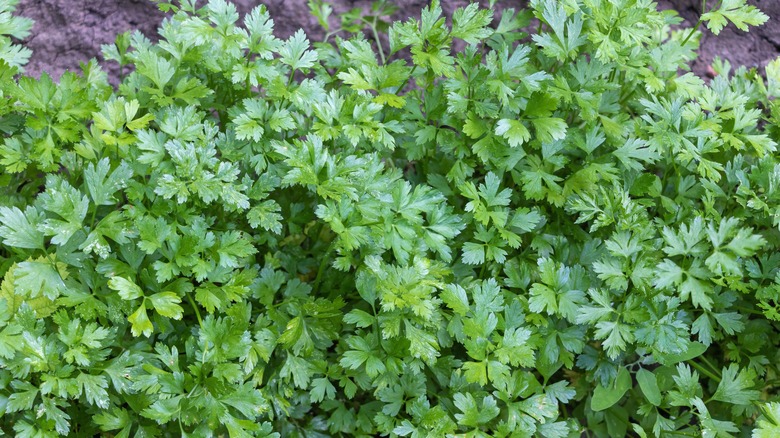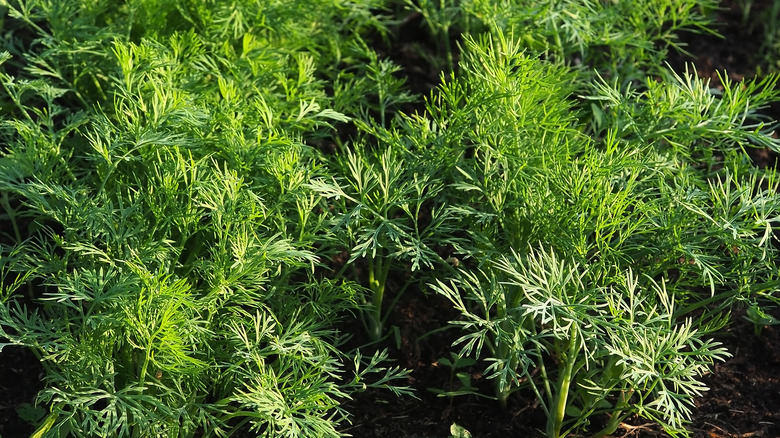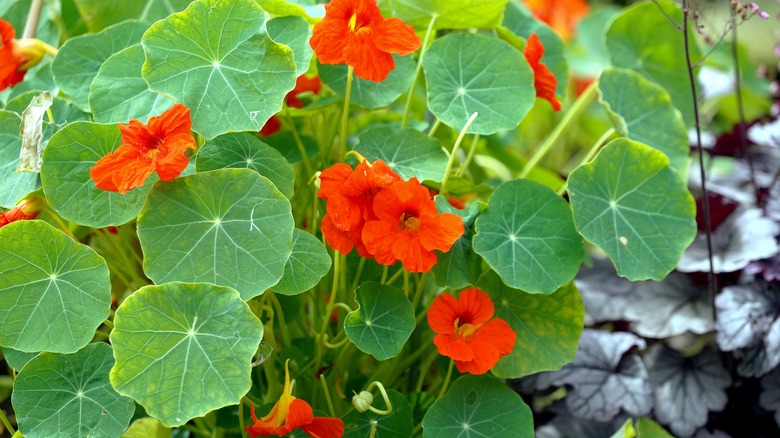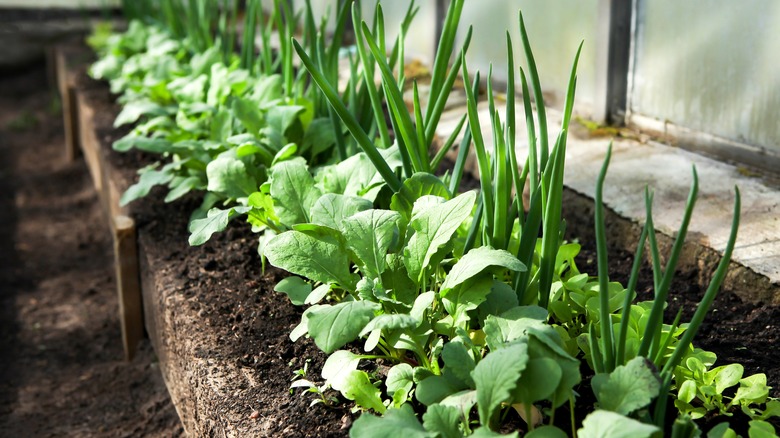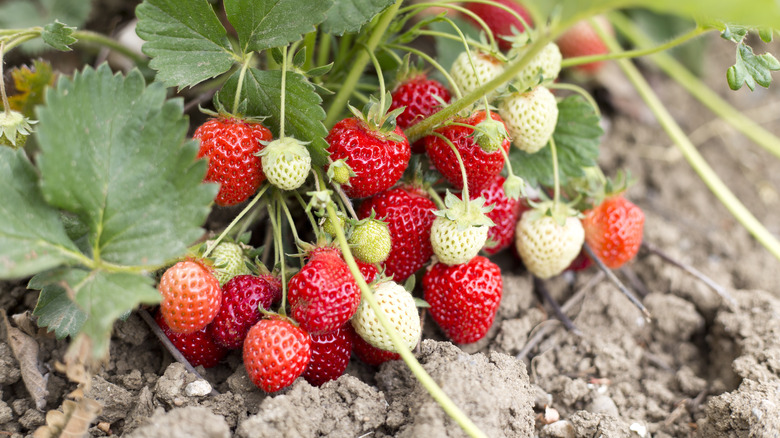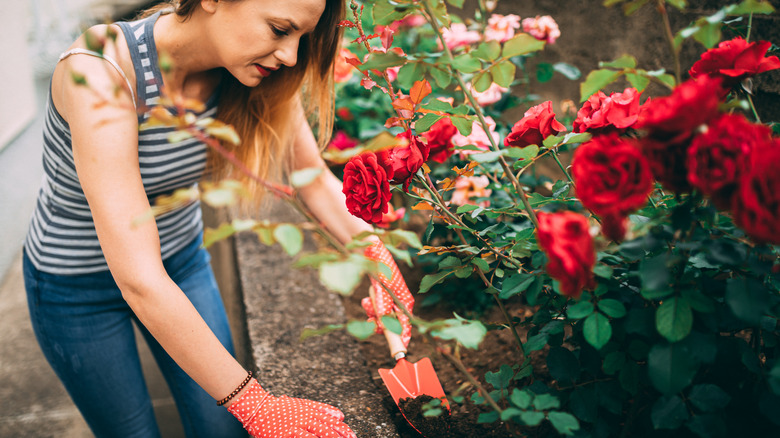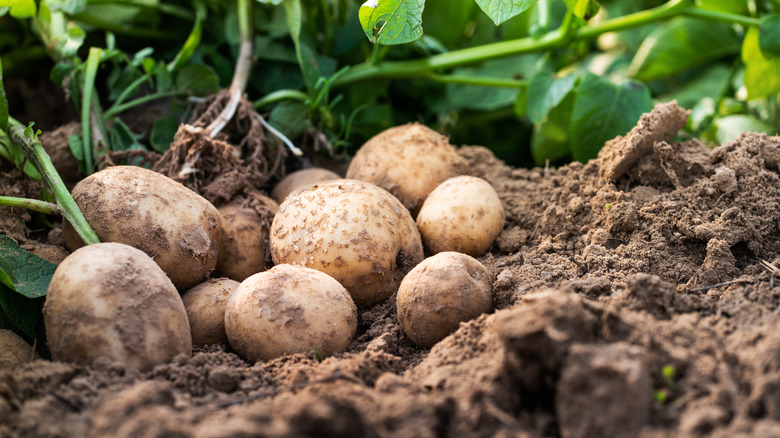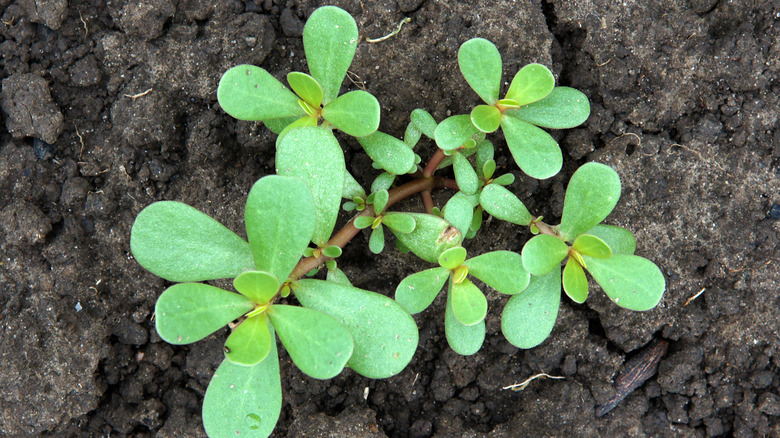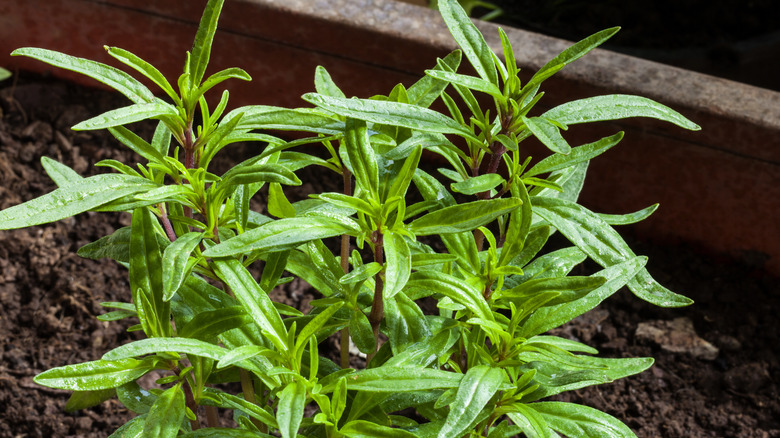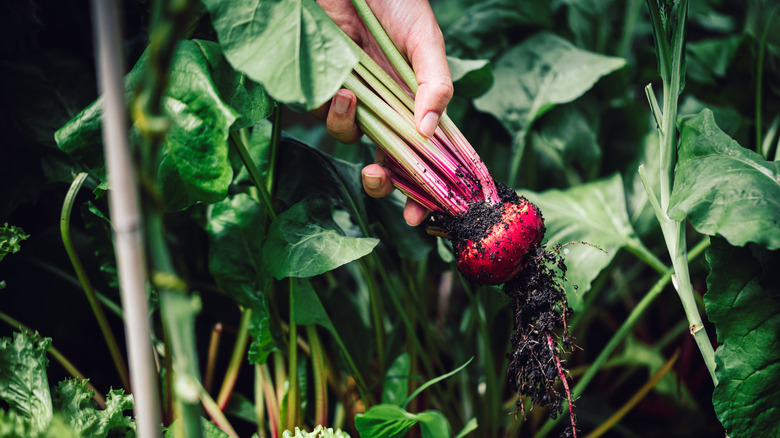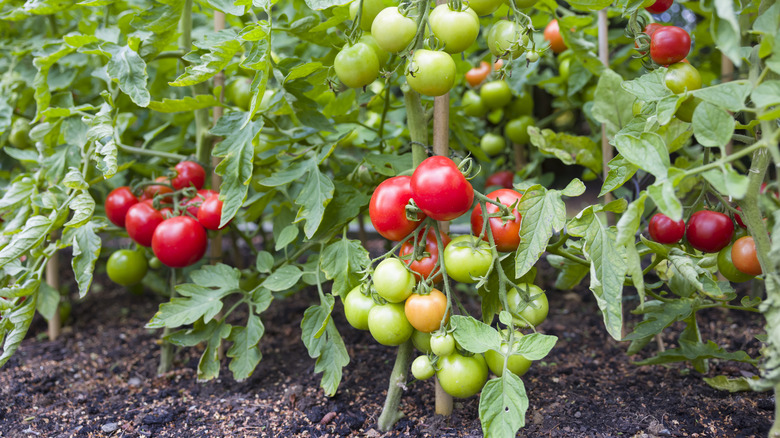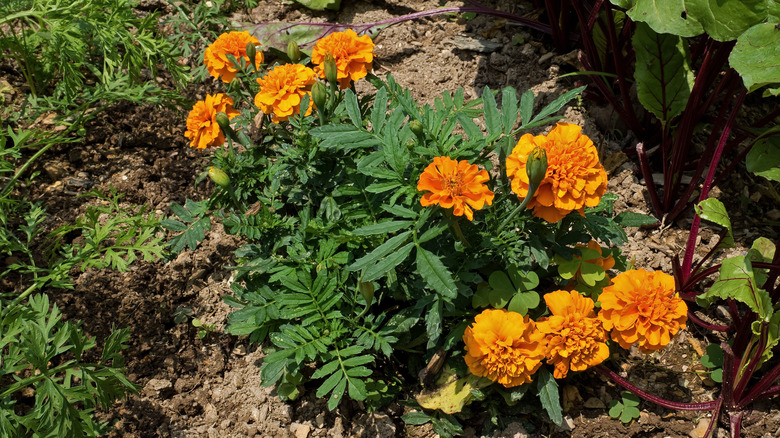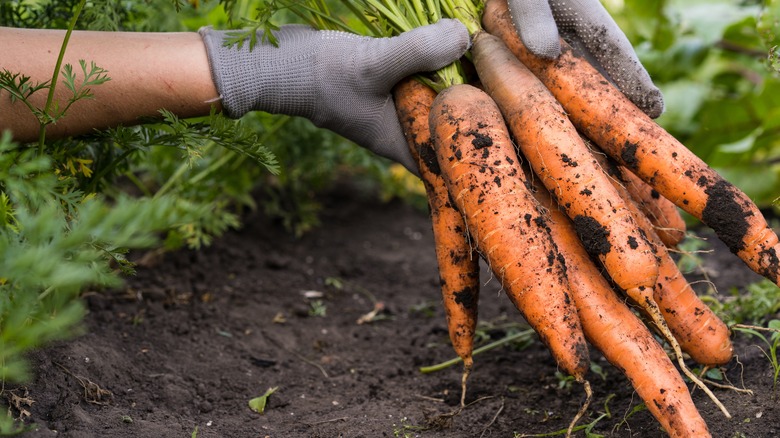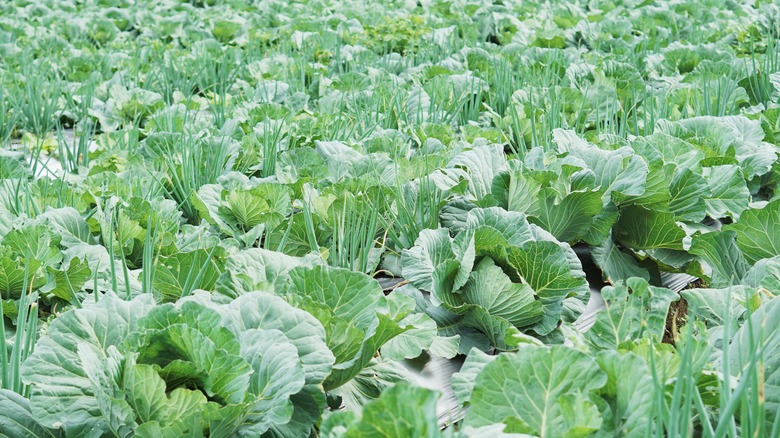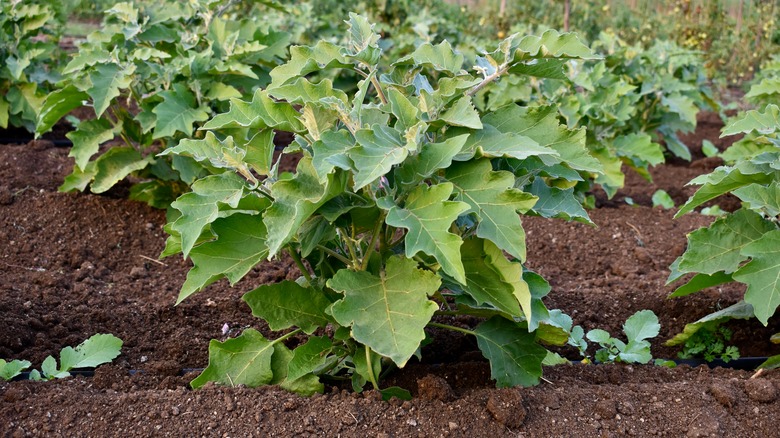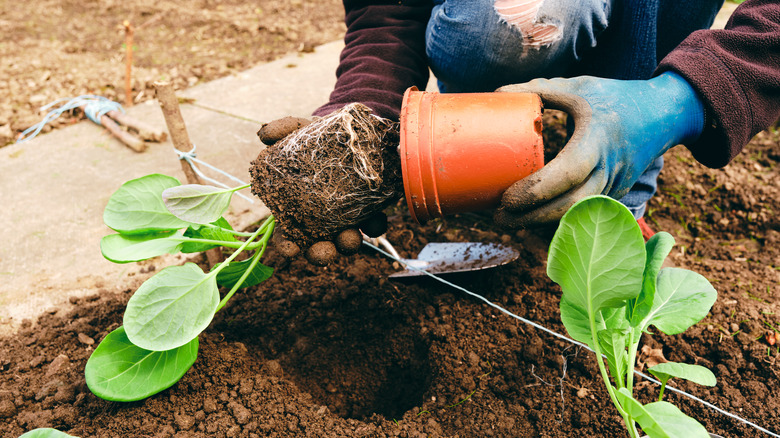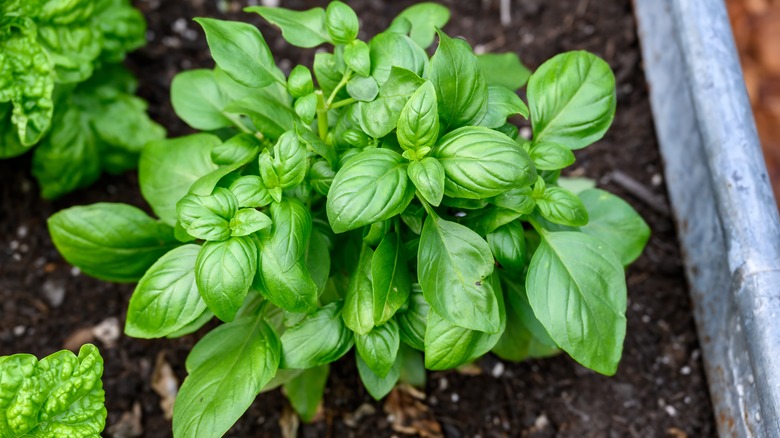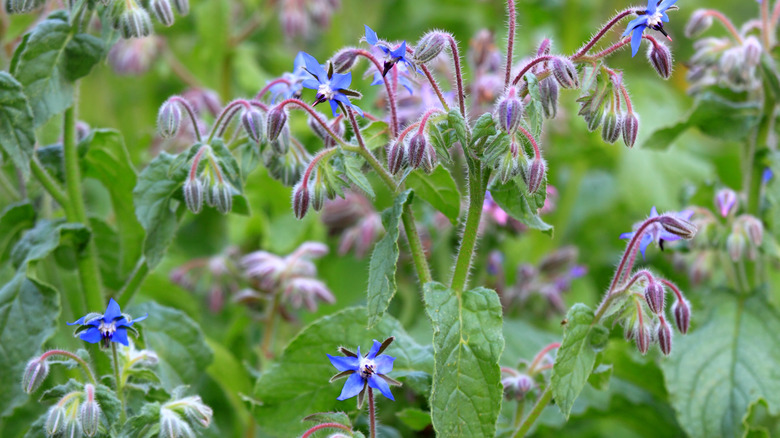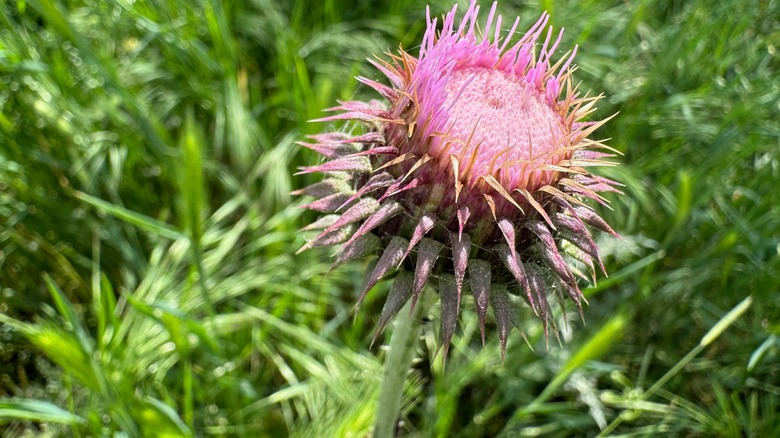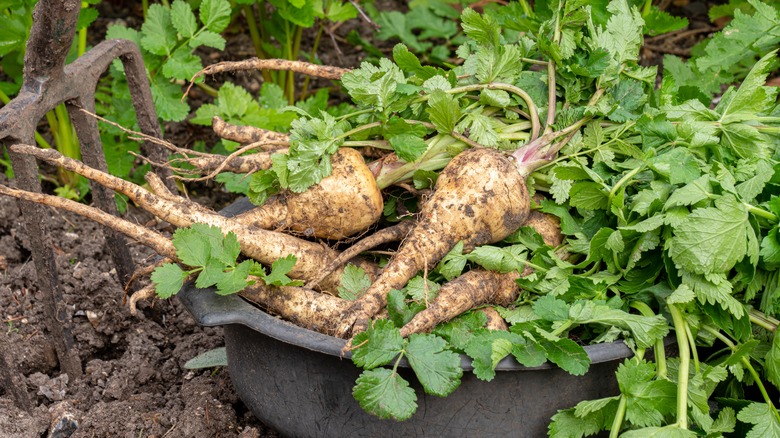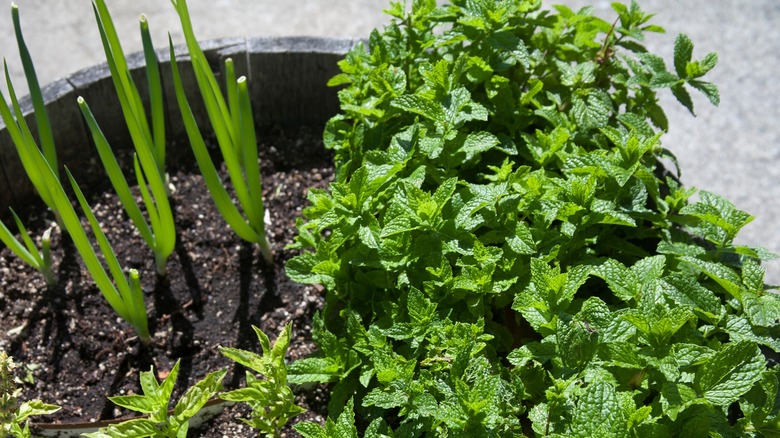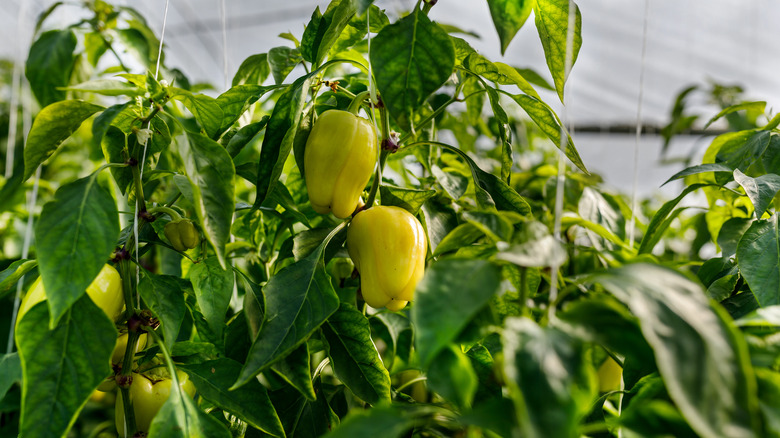24 Companion Plants That Are The Perfect Pair For Onions In Your Garden
Popping a few onion seeds, sets, or transplants in your garden bed and witnessing them flourish into full-blown bulbs is quite the buzz. But have you flirted with the idea of companion planting? It could level up your onion gardening game. Now, we are not talking about merely shoving plants side by side. It's more about crafting a community in your garden where plants are basically best friends, supporting each other to grow (and even taste) better. In this article, we'll explore the 24 best companion plants for onions — from lettuce, chamomile, rose, and dill to marigolds.
Speaking of specifics, some plants like basil, when planted next to onions, act as a powerful deterrent to those tiny insects notorious for nibbling on onion leaves. Then, there are the likes of marigolds which excel at killing root-knot nematodes. But don't think it's these companion plants for onions doing all the heavy lifting; onions bring their A-game too, offering protection against pests that might otherwise harm the neighbors.
Now, here's an unexpected twist. You'd think other members of the allium family (think garlic and leeks) would be ideal companions for onions, yet they fall short. They require similar nutrients and attract the same pests, so putting them together is a no-go. And let's be clear, companion planting isn't about just throwing seeds into the soil and hoping for the best. Careful thought must be given to the spacing, nutrient, and shade requirements.
1. Lettuce
Lettuce, with its rapid growth and low profile, is ideal underplanting for onions. The beauty here is that both plants' roots run at different levels in the soil, meaning they won't fight over nutrients. Plus, onions, empowered by a sulfur-backed pungent odor, deter pests attracted to lettuce (think spider mites, aphids, and carrot flies). Lettuce prefers cooler temperatures, thriving in spring and fall in most temperate regions. And it doesn't demand much — just some well-draining soil of pH 6.5 to 6.8 and a touch of shade from the taller plants on those hotter days.
2. Chamomile
With its daisy-like flowers and apple-scented foliage, chamomile is as lovely as it is beneficial, attracting helpful insects like hoverflies and parasitic wasps that keep onion pests at bay. It's also said to boost onion flavor, not to mention its flowers can be harvested and steeped into soothing tea. Both onion and chamomile share a penchant for full sun but will accommodate partial shade. A low-maintenance grass alternative, Chamomile thrives in well-draining soil, blooming throughout mid-summer well into frost. When planting, just sprinkle chamomile seeds lightly among the onion rows.
3. Parsley
Parsley isn't just a garnish; in the garden, it's a powerhouse companion for onions. Its dense, curly green, and fragrant foliage not only adds visual depth beneath taller onion stalks but also works to keep onion flies at bay. Thriving in similar conditions as onions, parsley appreciates full sunlight and consistently moist, well-draining soil to root in. Early spring or summer planting is ideal for parsley in most regions. Pop the parsley seeds 2 inches deep amidst your onions, and about a month later, thin the seedlings, leaving 10 to 12 inches of elbow room between the stronger remnants.
4. Dill
With its wispy fronds and towering presence, dill adds an almost whimsical element to the garden. It's a valuable companion plant for onions, attracting beneficial insects like ladybugs and lacewings. Dill's preference for sunny conditions and slightly acidic, well-draining soil mirrors that of onion plants, making them both compatible neighbors. As for planting dill, time when frost isn't a worry anymore is recommended. And heads-up: dill isn't a fan of transplanting, so sow its seeds directly in the soil, after which you thin the little sprouts to appreciable spacing.
5. Nasturtiums
Nasturtiums, with their fiery blooms and lush foliage, are the garden equivalent of a spicy bodyguard for your onions, offering defense against pests, including aphids and beetles, whether via their odor or stepping up as a trap crop. Happy in poor soil, these easily nurtured annuals are as undemanding as they come. They adore the sun but will tolerate partial shade, and while they're pretty drought-tolerant, they'll be grateful for a bit of extra watering during dry spells. Scatter nasturtium seeds around or within your onion patch in late spring after the last frost.
6. Radishes
Radishes, with their rapid growth, make for a strategic pairing with onions. They serve as a decoy for pests, drawing away the likes of root maggots, which might otherwise target onions. Onions, on the other hand, deter the radish-loving deer. These crunchy companion plants for onions favor cooler weather. Plant them alongside your onions in well-drained, slightly acidic to neutral soil in mid to late spring. You'll want to ensure they catch plenty of sunlight. Watch this duo keep pests in check while ramping up your garden's output and visual appeal.
7. Strawberries
Offering a beautiful shade-providing ground cover for onion bulbs, strawberries prefer cooler climates but adapt well to even cold winters if mulched properly to protect their roots. On the other hand, onion's pungent aroma naturally wards off pests like slugs and aphids that would otherwise chow down on your strawberries. Plant strawberries in well-drained, sandy loam soil with a pH between 5.3 and 6.5, and make sure they're soaking up enough sunshine. Remember to give them some breathing room (18 to 24 inches apart should do the trick).
8. Roses
Beyond their aesthetics, with types ranging from climbers and shrubs to groundcovers, roses find an unexpected ally in onions. The strong scent of onions is a huge turn-off for pests that love to mess with roses, including aphids. Additionally, onions and their fellow allium family members (think garlic) crank up rose's fragrance. Roses are picky about their space, though, preferring well-drained soil rich in organic matter and with a pH of 6 to 6.5. Regarding planting roses next to your onions, a sunny spot is their happy place to bloom in profusion.
9. Potatoes
Potato plants thrive alongside onions, given their roots run different depths and they share space without fighting over resources. Not to mention potatoes can step up as a trap crop for thrips, those critters infamous for munching onion foliage and transmitting nasty viruses. Plant potato seeds (ideally started a month before the last frost) in early to mid-spring. Ensure the soil is well-draining and compost-enriched. Furrows 6 inches deep are ideal for optimal growth. You want to space out between potato and onion rows to prevent potato foliage from casting too much shade over the onions.
10. Pigweed
Pigweed, with its dark green foliage, isn't your ordinary garden invader; it's a real boost for your onion patch. It attracts predatory insects and has a knack for pulling up deep-seated nutrients, benefiting the heavy-feeding onions. Adaptable to most soil types, provided they are moist, pigweed can grow just fine in sunny spots and a bit of shade. And when they mature, pigweed offers another surprise: it has highly nutritious leaves that can be a tasty addition to a variety of dishes. Allow some pigweed to grow within your onion patch but manage its growth to prevent overshadowing.
11. Summer savory
The slender, brown-green leaves and stems of summer savory are a forcefield against pests, especially the onion fly. This plant thrives in well-drained, loam, alkaline soil, enjoying full sun. It can grow robustly alongside onions, enhancing their flavor. To get it started, plant summer savory in early spring, after the last frost, to give it a headstart against the onion flies. And true to its name, this herb prefers a warmer climate but it's versatile enough to adapt to cooler areas if protected from harsh conditions.
12. Beets
Both root veggies, beets and onions share the garden space without a fuss over nutrients. Plus, beets get a bonus from onion's natural repellency against pests, deer, and rabbits. Suitable for growing in zones 5 to 10, beets prefer cool to mild weather. They do their best when planted in early spring (or late summer for a fall harvest) in well-drained, fertile soil. Intersperse the beets in rows alongside your onions, ensuring 2-inch spacing between the seeds. After thinning, let the remnant seedlings have a bit more elbow room, about 3 inches apart, so the veggies to spread out and flourish.
13. Tomato plants
Fancy a bounty of fruits and bulbs from the same green patch? Then, consider planting onions next to your tomatoes. Space efficiency aside, onions keep away those trouble-making aphids away from tomato plants. When the frost has waned, that's your cue to plant your tomato, ensuring they receive ideally eight to ten hours of sunlight daily. However, a shade fabric will suffice to protect your tomato plants from the summer sun. And given both crops have higher nutrient requirements, nurture them in compost-enriched soil. You want your staked tomato plants to reach for the sky without throwing too much shade on the onions below.
14. Marigolds
Marigold's bright, cheerful blooms are an excellent choice for gardeners seeking to step up the aesthetics of their onion patches. While both plants emit potent fragrances that excel at deterring a host of insects, marigolds bring a little extra to the party with their subterranean magic. Their roots release a nematicidal chemical known as alpha-terthienyl, shielding your onions against the growth-stunting root nematodes. Thriving in sunny conditions and best planted in spring after the last frost, marigolds are hardy across most planting zones. They do well in well-drained soil and can tolerate a bit of neglect, making them perfect for busy gardeners.
15. Carrots
The relationship between carrots and onions is nothing short of symbiotic, unlike scenarios where onions do the heavy lifting. Onions' fragrance confuses and deters carrot flies, while carrots, in turn, help with loosening soil. Both plants have different root depths and won't compete heavily for nutrients. Carrots prefer cooler weather and flourish best in hardiness zones 3 through 10. They need well-drained, slightly acidic to neutral soil rich in organic matter. Shallower is better with carrot seeds but ensure your garden soil allows for deep penetration. Plant carrots and onions together in early spring, arranging them in alternating rows to exploit their mutual benefits fully.
16. Cabbage
In this companionship, the strong-smelling onions repel cabbage's biggest foes, including cabbage worms and aphids. Cabbages are cold-hardy and favor well-draining, moisture-retaining, slightly acidic to neutral soil enriched with mature compost or manure. Early spring is the perfect time to introduce cabbage seedlings started indoors to your two-week-old onion plants. But remember, these companions love space, both for growth and air circulation — aim for 15 to 18 inches. A steady watering schedule (1 inch of water per week for non-sand soils) is crucial not just for growth but also keeping the taste of your cabbage sweet.
17. Eggplants
Eggplant is another plant that does well alongside onions, benefiting from the latter's potency against pests. It's a heat lover, thriving in full sun and warm soils in zones 5 through 12. As for the soil specs, consider pH 6 to 7, well-draining, and rich in organic matter. Start seeds indoors about two months before the last frost and harden off (the garden term for acclimating) the seedlings about two weeks before transplanting. The best time of the year to plant eggplant is after the final frost when the soil has warmed. Keep them watered, especially when the weather is on the dry side.
18. Brussels sprouts
As companion plants, onions deter common pests that love to feast on Brussels sprouts, while the sprouts themselves don't infringe on the onions' nutrients. Brussels sprouts flourish in cooler weather, with zones 2 to 11 with well-draining soils of pH 6 to 8 being their prime spots. They need a long growing season — plant them in early summer and you're setting yourself up for a fabulous fall harvest. Remember, Brussels sprouts like their personal space (2 feet is ideal) and appreciate being sheltered against winds that could topple them over.
19. Basil
Basil, with its lush, fragrant leaves, is not just for pesto. Pairing it with onions works like a charm in the garden due to its natural ability to repel thrips, sneaky critters infamous for distorting onion leaves. Basil enjoys full sun and warm conditions and is ideally planted in early summer. For optimal proximity in the growth bed, sprinkle basil seeds among your onions and give them a light cover of soil. Basil seeds demand consistently moist soil until they germinate a week later, after which you space out the seedlings to about 8 inches apart. Regular watering and occasional pruning will keep your basil healthy.
20. Borage
Borage has a symbiotic relationship with onions by attracting predatory insects like hoverflies and wasps which feast on garden pests. Growing borage is a breeze. The plants are happy to settle in most garden soils and while they love spots drenched in sunlight, they won't throw a fit in partial shade. Plant borage seedlings or seeds in early spring, letting the seedlings grow around 12 inches apart. These companion plants for onions are not the type to demand high-maintenance feeding routines, rather preferring the natural richness of compost-enriched soil.
21. Common thistle
Common thistle (sometimes called bull thistle) is a beneficial companion plant for onions for various reasons. First, its flowers are a delicious snack for predatory birds like the goldfinch,which can help deter pests. Its deep roots can break up compacted soil, but more importantly, they draw valuable nutrients from the subsoil and share them with the shallower onion roots nearby. The thistle is quite the trooper, too, as it's not picky about soil types and pH levels. As long as the ground is moist but well-drained, the plant requires little care beyond monitoring for invasive tendencies.
22. Parsnips
Parsnips are yet another great neighbor for onions. During spring and summer, these low-maintenance root vegetables produce yellow flowers and attract beneficial insects that prey on onion pests. Parsnips need cooler weather to develop their sweet flavor, making them ideal for planting in early to mid-spring. Give them a sunny spot with deep, rich, well-drained soil, and they'll be happy to flourish into the bestowed veggies of your liking. And because they don't do well when started indoors, stagger their seeds amongst your onions and once the seedlings are 1-inch tall, space them to about 6 inches apart.
23. Mint
Mint doesn't just bring a burst of cool flavor to the table; it's a superhero in the garden when paired with onions. Doing well in full sun to partial shade, this aromatic perennial repels a whole host of onion pests like onion flies and aphids. Although it loves moisture, it demands well-draining soil to prevent root rot. However, mint's growing methods are as flexible as its uses. Nestle the seedlings, cuttings, or divisions alongside your onions in spring or early fall. Be wary of mint's tendency to spread, though. Planting it in pots or within a barrier will prevent a potential herbaceous takeover in your onion patch.
24. Pepper
Closing the curtain on the companion plants for onions, pepper enjoys pest protection and a nice boost in flavor from its allium neighbor. Plus, if you've got Charleston Belle peppers, you can expect onions to benefit from its knack for fighting nematodes. Preferring full sunlight and thriving in USDA zones 9-11, pepper is a summer season star ideally planted in spring after the threat of frost wanes and temperatures consistently hover between over 70 and 80 degrees Fahrenheit. While they're not fussy about soil pH — try and keep it between 6.0 and 6.8 and space the transplants 18 inches apart along onion rows.
